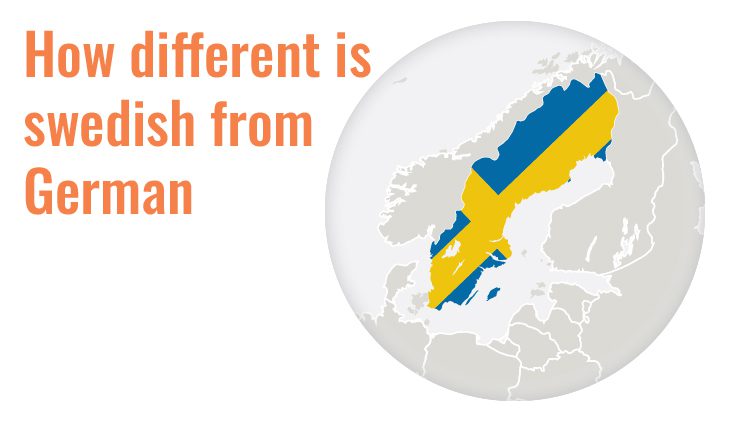
Exploring the Shared Traits: Similarities Between Swedish and German
When comparing Swedish and German, you might be surprised to discover quite a few similarities between the two languages. First and foremost, Swedish and German are part of the Germanic language family, meaning they share a common origin. This means that there are many similarities in their grammar and vocabulary.
For example, both languages have definite and indefinite articles and similar sentence structures. Additionally, there are similarities in pronouncing certain sounds, such as the "r" sound, rolled in Swedish and German.
Furthermore, both languages have influenced each other over the years due to their close geographic proximity and cultural ties. German has significantly influenced the Swedish language, especially regarding loanwords and cultural concepts. On the other hand, Swedish has also influenced German in certain regions, particularly pronunciation.
Overall, while there are certainly differences between Swedish and German, it is essential to recognize and appreciate their similarities. Understanding these similarities can help language learners bridge the gap between the two languages and enhance their learning experience.
Pronunciation differences
One of the critical differences between Swedish and German lies in their pronunciation. While both languages share certain similarities in their sounds, distinct differences set them apart.
For English speakers, Swedish pronunciation may seem more familiar compared to German. Swedish has a softer, melodic tone, with vowels pronounced more openly and clearly. In contrast, German pronunciation can sound harsher to the untrained ear, emphasizing consonants more heavily.
One notable difference is the "r" sound. In Swedish, the "r" is rolled or trilled, similar to the Spanish "rr" sound. On the other hand, German has a guttural "r" sound that is produced at the back of the throat.
Another difference lies in the vowels. Swedish has nine vowel sounds, including some unique ones not found in English, such as the long and short "å" and the long and short "ö." German, on the other hand, has more vowel sounds, including umlauted vowels like "ä," "ö," and "ü," which can be a challenge for English speakers to master.
While Swedish and German have similar sounds, they also have distinct pronunciation differences reflecting their linguistic and cultural heritage. Mastering the pronunciation of each language can significantly enhance your ability to communicate and understand Swedish and German speakers.
Grammar differences
When it comes to grammar, Swedish and German have some notable differences. One of the key distinctions is the use of definite and indefinite articles. Swedish has no indefinite article, while German has both definite and indefinite articles. For example, "the cat" would be "katten" in Swedish and "die Katze" in German, but "a cat" would be "katt" in Swedish, whereas in German, it would be "eine Katze".
Another difference lies in the noun gender. German has three genders (masculine, feminine, and neuter), which determine the article and adjective endings, while Swedish does not have noun genders. This means that Swedish speakers may find it easier to learn German noun genders compared to speakers of languages without noun genders.
Additionally, word order can differ between the two languages. While both languages generally follow a subject-verb-object word order, Swedish allows for more flexibility, allowing the verb to be placed before the subject or object in certain situations. On the other hand, German has a more rigid word order, with the verb usually coming in the second position.
Overall, while there are some similarities in grammar between Swedish and German, there are also distinct differences. Understanding these differences can help language learners navigate the grammatical aspects of each language and improve their proficiency in both.
Vocabulary differences
Regarding vocabulary, Swedish and German have their own unique sets of words and expressions. While both languages share some common roots and loanwords from other languages, their vocabulary also has distinct differences.
Swedish, as a Scandinavian language, shares some similarities with other Nordic languages, such as Norwegian and Danish. Swedish may share some common words and expressions with its neighboring languages. On the other hand, German, as the official language of Germany and a widely spoken language in many European countries, has a rich vocabulary influenced by its unique history and cultural background.
Regarding vocabulary differences between Swedish and German, one notable distinction is the use of definite articles. Swedish has only one definite article, "den," used for singular and plural nouns. German, on the other hand, has different definite articles for each gender and number. For example, "the cat" would be "katten" in Swedish, while it would be "die Katze" in German. This distinction in definite articles can sometimes lead to confusion for language learners, but with practice and exposure to the language, it becomes easier to navigate.
Another vocabulary difference lies in using specific terms and expressions in different contexts. As a language with a strong cultural and economic presence, German has a rich vocabulary for specialized fields such as engineering, technology, and philosophy. Swedish may have fewer specialized terms while also having its specific vocabulary.
To expand your vocabulary in both Swedish and German, it can be helpful to use online dictionaries and language-learning resources that provide translations and explanations of words and phrases. You can enhance your understanding and fluency in Swedish and German by actively practicing and incorporating new vocabulary into your language-learning journey.
Cultural differences and influence on language
Cultural differences and influence on language play a significant role in distinguishing Swedish from German. Sweden, a Nordic country, and Germany, a central European country, have unique cultural identities that have shaped their respective languages.
Their historical and bilateral relations have influenced Swedish and German. Over the years, Germany has considerably impacted the Swedish language, particularly in terms of loanwords and cultural concepts. For example, words related to technology and industry often have German origins in Swedish.
On the other hand, Swedish has also influenced German in certain regions, especially regarding pronunciation. Swedish has influenced the pronunciation of German in northern Germany, where the guttural "r" sound is replaced by the rolled or trilled "r" sound similar to Swedish.
Additionally, cultural differences between the two countries have influenced their vocabularies. As a prominent economic and cultural power, Germany has a rich vocabulary for specialized fields such as engineering, technology, and philosophy. Swedish may have fewer specialized terms while also having its specific vocabulary.
Understanding the cultural differences and influences on language can deepen your appreciation for the unique characteristics of both Swedish and German. By embracing these cultural differences, language learners can better understand the two languages and their connection to their respective societies.
Swedish vs. German word order
One key aspect that sets Swedish and German apart is their word order. While both languages generally follow a subject-verb-object (SVO) word order, there are some essential differences.
In Swedish, word order is relatively flexible, allowing for more variation than in German. This means the verb can be placed before the subject or object in certain situations. For example, "I see a cat" can be translated as "Jag ser en katt" in Swedish, with the verb "ser" (see) coming before the subject "Jag" (I). This flexibility in word order allows for emphasis or stylistic variation in Swedish sentences.
In contrast, German has a more rigid word order, with the verb usually coming in the second position. This is known as the verb-second (V2) rule. For example, "I see a cat" in German would be "Ich sehe eine Katze," with the verb "sehe" (see) in the second position after the subject "Ich" (I). This consistent word order helps to maintain clarity and structure in German sentences.
These differences in word order can be challenging for language learners, but understanding them is crucial for constructing meaningful and grammatically correct sentences in both languages. By familiarizing yourself with the specific word order patterns in Swedish and German, you can effectively communicate your thoughts and ideas in each language.
Inflectional Changes in Swedish and German
Inflectional changes in Swedish and German are crucial in understanding and distinguishing between the two languages. Swedish and German exhibit inflectional changes, which involve altering the form of words to convey grammatical information such as tense, number, and case. However, some notable differences exist in how inflectional changes are applied in each language.
In German, nouns and adjectives are inflected for case, gender, and number. This means that depending on their role in a sentence, these words change to indicate whether they are the subject, object, or possessive. For example, in German, the adjective "beautiful" can have different forms depending on whether it describes a masculine, feminine, or neuter noun.
On the other hand, Swedish inflectional changes are relatively simpler. Nouns in Swedish are inflected for number and definiteness, while adjectives do not change form based on gender or case. Additionally, Swedish does not have grammatical gender, meaning all nouns are considered neuter in terms of grammatical agreement.
Understanding the inflectional changes in Swedish and German is crucial for constructing grammatically correct sentences and comprehending written and spoken texts. By recognizing the specific inflectional patterns and applying them correctly, language learners can effectively convey their ideas and thoughts in Swedish and German.
In summary, while Swedish and German exhibit inflectional changes, there are differences in the complexity and application of these changes. German emphasizes inflectional changes for gender and case, while Swedish focuses more on number and definiteness. By grasping these distinctions, language learners can enhance their proficiency in both Swedish and German and navigate the intricacies of each language's grammar.
Frequently Asked Questions
Both languages belong to the Germanic language family but have distinct linguistic roots. That share some vocabulary due to their common ancestry, but their grammar, pronunciation, and sentence structure are notably different.
While there might be some cultural overlaps due to both countries being in Europe, cultures have unique characteristics. Sweden is known for its egalitarian values and minimalist design, whereas Germany is renowned for its engineering prowess and rich history.
There might be limited mutual intelligibility due to shared linguistic roots, but both speakers generally can't easily understand each other. Learning the other language would still be necessary for effective communication.
Swedish has a subject-verb-object (SVO) word order, similar to English, while German often uses a subject-object-verb (SOV) word order. German also has complex case systems and noun genders, absent in Swedish.
https://www.universal-translation-services.com/how-similar-or-different-are-swedish-and-german/


Comments
Post a Comment